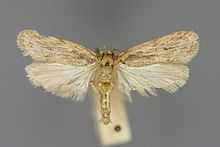Depressaria radiella
| Depressaria radiella | |
|---|---|
 | |
| Scientific classification | |
| Kingdom: | Animalia |
| Phylum: | Arthropoda |
| Class: | Insecta |
| Order: | Lepidoptera |
| Family: | Oecophoridae |
| Genus: | Depressaria |
| Species: | D. radiella |
| Binomial name | |
| Depressaria radiella (Goeze, 1783)[1] | |
| Synonyms | |
| |
The Parsnip Moth (Depressaria radiella) is a moth of the Oecophoridae family. It is found in most of Europe, except Portugal and most of the Balkan Peninsula.

The wingspan is 19–27 mm.[2] Adults are on wing from August to (after overwintering in a sheltered place) May of the following year. There is one generation per year.
The larvae feed on Heracleum sphondylium, Pastinaca sativa and Apium nodiflorum. They feed on the flowers and developing seeds. Pupation takes place in the main stem of the food plant.[3]
Taxonomy
Depressaria radiella is the type species of the Depressaria genus. Its scientific name has been much confused for about 200 years. A.H. Haworth, on establishing the genus Depressaria in his 1811 issues of Lepidoptera Britannica, called the eventual type species Phalaena heraclei, an unjustified emendation of P. (Tortrix) heracliana. In this he followed such entomologists of his time as A.J. Retzius, who in 1783 had believed the Parsnip Moth to be a species originally described by C. Linnaeus in 1758. But in fact, this was a misidentification; Linnaeus' moth was actually the one known today as Agonopterix heracliana. To make matters worse, J. Curtis popularized another incorrect spelling, D. heracleana, apparently first introduced (as Pyralis heracleana) by J.C. Fabricius in his 1775 Systema Entomologiae.[4]
When the error of Retzius, Haworth and others was realized, it was assumed that the Parsnip Moth was only validly described (as Haemilis pastinacella) by P.A.J. Duponchel in 1838, and consequently it was throughout much of the 20th century known as D. pastinacella. But according to the ICZN's judgement, there already was an older valid description – that of J.A.E. Goeze, who in 1783 named the species Phalaena radiella. Thus, the correct scientific name of the type species is D. radiella.[4]
References
- ↑ Fauna Europaea
- ↑ microlepidoptera.nl
- ↑ Lepidoptera of Belgium
- ↑ 4.0 4.1 Pitkin & Jenkins (2004)
- Pitkin, Brian & Jenkins, Paul (2004): Butterflies and Moths of the World, Generic Names and their Type-species – Depressaria. Version of 2004-NOV-05. Retrieved 2010-APR-24.
External links
| Wikispecies has information related to: Depressaria radiella |
| Wikimedia Commons has media related to Depressaria radiella. |